Can you tell if this introduction was written by AI or a human?
You certainly can’t tell because in 2025, AI writing has come a long way, and so have the people using it.
With the right prompts, you can generate AI content that feels almost indistinguishable from something written by an actual person.
AI-written content flows, sounds natural, and passes most people’s gut check.
That’s exactly why detecting AI-generated text has become such a major topic, especially since 2023, when generative AI exploded into everyday use.
Now, AI content is in essays, blog posts, in our inbox, on our feed, and might even be on that company website you trust.
So, how do you tell what’s real?
That’s exactly what we are going to cover. In this blog, we’ll break down the subtle signs that suggest the content was written with AI, the scenarios where AI detection matters, the best AI detection tools available in 2025, and the limitations that still exist.
Let’s dive in.
Signs That Content Might Be AI-Generated
Detecting AI writing has gotten challenging, but it still leaves clues that human writers don’t.
Here are the signs to look for:
- Repetitive phrasing or structure – AI uses similar patterns and phrases throughout a text.
- Example: One important aspect is… Another important aspect is.. The final important aspect is…
- Lack of personal anecdotes – Real people naturally share bits of their lives.
- Example: AI can’t authentically say “Last week at the grocery store…” because it hasn’t lived a life.
- Overuse of transition words – When every paragraph starts with “Furthermore,” “Moreover,” or “In conclusion,” It’s a red flag – humans don’t talk like that all the time.
- Perfect grammar but mechanical tone – AI-generated text often sounds technically correct but robotic.
- Example: The implementation of the aforementioned strategy will potentially yield substantial benefits in terms of operational efficiency and customer satisfaction metrics across multiple departmental divisions.
- Surface-level insights without depth – AI gives facts and general ideas but rarely dives deep or offers original perspectives.
- Example: Leadership is important for business success. Good leaders motivate their teams. They also make strategic decisions. Leadership skills can be developed through practice. (Nothing wrong, but nothing insightful either)
- Unusual consistency across long content – Human writing quality naturally varies when we’re tired or excited. AI maintains the same tone and quality throughout.
- Example: A 3,000-word article where paragraph 27 has the exact same energy, detail level, and writing style as paragraph 1 – no peaks, valleys, or signs the writer got tired.
- Mathematical precision in word counts – If someone asked for 500 words, a human might write 487 or 523, but AI will deliver exactly 500.
AI struggles with complex storytelling. It connects patterns, not ideas, and can’t draw from personal experience or genuine emotion.
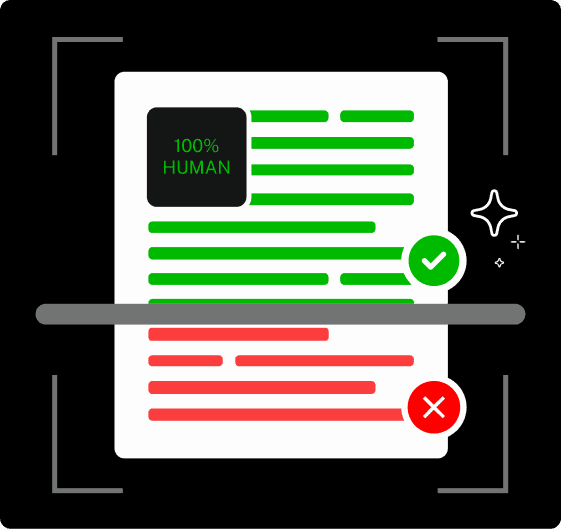

Never Worry About AI Detecting Your Texts Again. Undetectable AI Can Help You:
- Make your AI assisted writing appear human-like.
- Bypass all major AI detection tools with just one click.
- Use AI safely and confidently in school and work.
When Should You Check for AI Writing?

AI writing is everywhere these days. It’s projected that by 2026, up to 90% of online content may be AI-generated text.
We don’t consider using AI assistance as inherently wrong, especially if it helps improve quality. But it shouldn’t replace proper research or fact-checking.
That said, here are the key sectors where checking for AI-generated content is especially important.
- Academic environments:
Schools and universities can’t afford to play fast and loose with academic integrity.
When students pass-off AI-generated work as their own, they miss out on the learning process entirely.
Over time, degrees lose their value because they no longer reflect real skill or knowledge.
- Journalism/newsrooms:
Reader trust is everything. Newsrooms spend years building it—and one AI-written article can tear it all down overnight.
If that piece includes inaccuracies or AI hallucinations (which it often does), it’s not just embarrassing. It’s a liability.
You risk lawsuits, public backlash, and long-term damage to your brand.
- Client content submissions:
Clients don’t pay premium rates for AI shortcuts.
They’re investing in human expertise—original thinking, deep insights, and quality that only comes from experience.
Delivering AI-written content instead might be considered fraud.
- SEO content audits:
In Google’s February 2025 update, they made it crystal clear that content must show authenticity and expertise.
If your pages are filled with shallow, AI-generated content, they won’t rank. Worse, your entire domain could get penalized.
Google’s 2025 content guidelines no longer focus on “how” content is created but instead emphasize the E-E-A-T framework:
- E – Expertise
- E – Experience
- A – Authoritativeness
- T – Trustworthiness.
While they don’t automatically penalize AI content, their systems now effectively identify content that lacks authentic expertise or original value.
How to Check for AI Writing
There are several effective ways for detecting AI writing in content:
1. Start With Manual Checks
Read the content out loud. Does it flow naturally? Does it sound like someone with lived experience?
AI-written content typically has:
- No creativity.
- Perfect grammar, but the tone feels cold or flat.
- Same sentence structures again and again.
- No strong opinions or emotions.
2. Use Online Detection Tools
Some websites and tools scan content and tell you if it might be AI.
Some are free, others are paid—but none are 100% accurate.
Top tools to try for AI detection:
Another option worth checking out is TruthScan — a reliable platform designed to spot AI-generated writing and imagery with deep forensic precision.

It’s especially useful when you need to verify if content is authentic before publishing, especially in high-stakes environments like academia, journalism, or client work.
TruthScan combines multi-source scanning with fact-checking support, helping ensure your work stands up to scrutiny.
3. Look at Structure and Tone
AI often writes in a weirdly balanced way. Like:
- Every paragraph is almost the same length.
- The intro and conclusion feel too perfect.
There’s no personality, no mess, no voice.
Try “reverse-engineering” it:
- Ask: Would a real person write it this way?
- Look for quirks or unique opinions. If there are none, that’s a flag.
4. No Method Is Perfect — Use a Mix
Truth is, no single tool or trick can say for sure. Even the best AI detector can be wrong sometimes.
So the best way to check for AI writing is to use a few methods together. Trust your instinct. Run it through a tool. Ask others to read it.
That’s how you get closer to the truth.
Best AI Detection Tool
Here are the three best ways for detecting AI-generated text in 2025.
- Undetectable AI
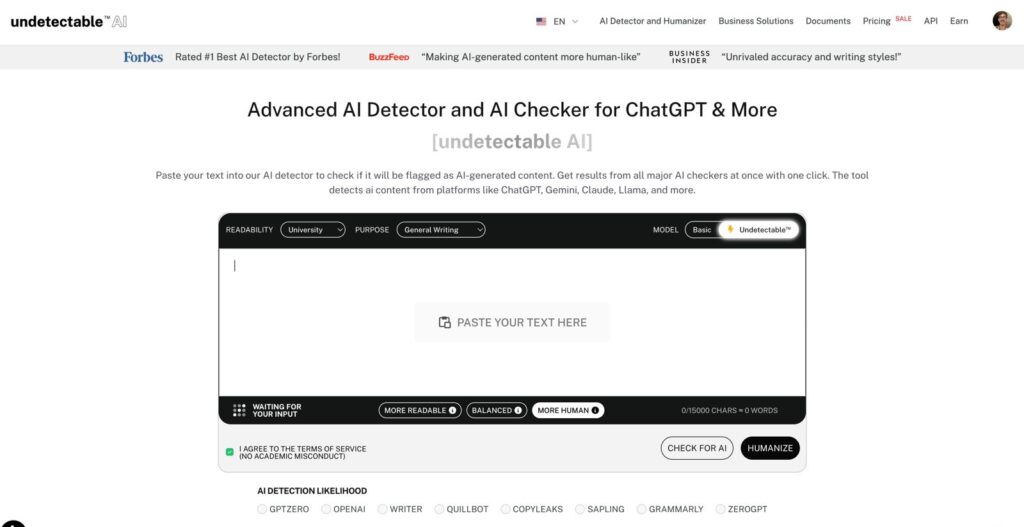
Undetectable AI was rated #1 AI detector by Forbes, with over 5,000,000 users as of early 2024.
Good for: Bypassing AI detection while rewriting. Real-time readability optimization and multi-detector comparison across major tools
Not good for: Short texts under 200 words, and plagiarism detection
Accuracy: 85–95% (third-party tested across multiple engines)
Price:
- $5/month (annual plan)
- $19/month (monthly)
- Custom pricing for businesses
- 50% off annual plans
2. GPTZero
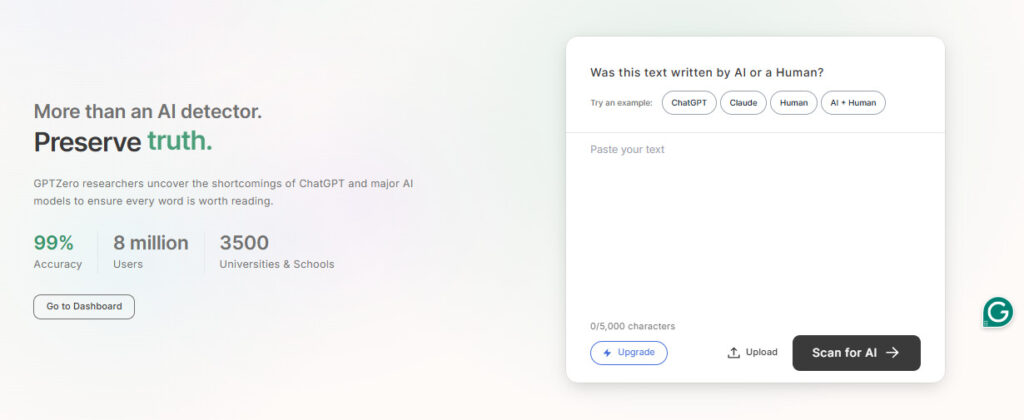
GPTZero is a simple, easy-to-use tool that focuses on spotting AI authorship at the sentence level.
Good for: Educational and academic institutions. Sentence-level AI detection and highlighting. Integrating with LMS platforms
Not good for: Small teams or casual users (pricing may be high), or detecting newer, niche AI models
Accuracy: Up to 99% (especially strong on sentence-level detection)
Price:
- $15/month (150K words)
- $24/month (300K words)
- $35/month (500K words)
3. Originality.AI

Originality.AI is an AI detector tool endorsed by WriterAccess, agencies, and major publishers for reliable detection and advanced plagiarism checks.
Good for: Agencies, publishers, SEO teams. High-volume, deep detection with API integration.
Not good for: Students or individual academic use. Free/low-budget use (no free tier, credit card required)
Accuracy: 99% (tested across GPT-4o, Claude 3, Gemini, Llama)
Price:
- $14.95/month (2,000 credits)
- $30 pay-as-you-go (3,000 credits)
- Enterprise custom pricing
If you’d like to explore further, check out our list of the best 10 AI plagiarism detection tools of 2025—read the full blog here.
How to Use Undetectable AI’s AI Detector
Getting flagged for AI-generated content can be frustrating — especially when you’ve worked hard to make it sound human.
Undetectable AI helps fix that. It is an award-winning AI detector featured in Business Insider, ABC, CBS, NBC, Yahoo Finance, Fox, Lifewire, and Nature. Here’s how to check for AI writing:
Step 1: Go to the Website
Visit Undetectable AI. No sign-up required.
Step 2: Paste Your Content
You’ll see a large box labeled “PASTE YOUR TEXT HERE.” Simply copy and paste your content — at least 200 words.
Step 3: Choose Your Tone
Pick from three rewriting styles:
- More Readable – Simplifies everything.
- Balanced – A nice middle ground between clarity and detail.
- More Human – Best if you want to sound natural and bypass AI detectors.
For best results, go with “More Human.”
Step 4: Check Your AI Scores
The tool runs your text through detectors like GPTZero, OpenAI, Copyleaks, and Grammarly. You’ll see the percentage each believes is AI-written.
Step 5: Hit ‘Undetectable™’
If your AI score is too high, just click “Undetectable™.” It rewrites your content to make it more human-like.
Limitations of AI Detectors
No AI detector is 100% accurate. At the end of the day, they’re also a machine judging another machine. Here are the different limitations of when detecting AI writing:
- False Alarms (False Positives/Negatives)
- False positive – when an AI detection tool says content is AI-generated, but it was actually written by a human.
- False negatives – when an AI detection tool says the content was written by a human, but it was actually created by AI.
That’s risky if you’re relying on the tool to catch it all.
- Tricked By Smart Paraphrasing
If someone rewrites or paraphrases AI-generated text just a little — many detectors can’t tell the difference.
Especially if you run it through humanizing tools or change the tone manually. That’s because detectors often look for patterns — and those can be masked.
- AI Models Move Faster Than Detectors
The AI models that write content get smarter faster than the tools trying to catch them.
New models like GPT-4o, Claude 3, and Gemini evolve quickly, and detectors don’t always keep up.
- Confidence Isn’t Certainty
Just because a tool says “90% likely AI” — that doesn’t mean it definitely is.
You still need human judgment, context, and sometimes, more than one tool.
How to Make AI Writing Less Detectable
AI writing tools are great at generating content quickly, but they sometimes leave behind clues that make it easy to spot.
If you’re looking to make AI-generated text sound more like something a human would write, using the right tools can make all the difference.
Here are three tools that can help you refine your AI writing and make it less detectable:
AI Humanizer
AI Humanizer turns AI-generated text into smooth, natural content that passes as human-written. It:
- Adjust the tone to be more casual, formal, or storytelling.
- Improves readability, making your content flow more naturally.
Best for: Refining AI content for blogs, social media, or customer-facing text.
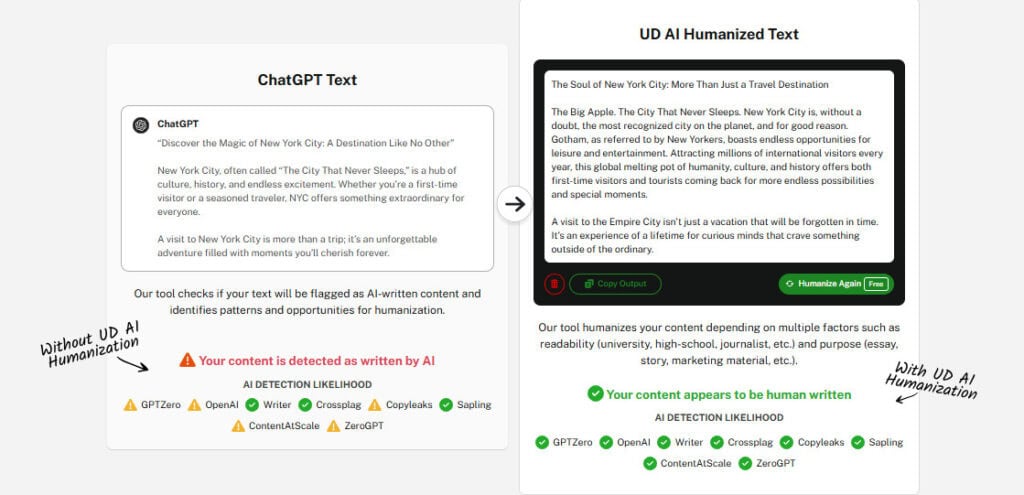
Stealth Writer
Stealth Writer reworks AI content to make it sound entirely human. It:
- Rephrases content with unique phrasing, structure shifts, and idioms.
- Transforms text to sound like it was written by a human, passing AI detection.
Best for: Rewriting content to make it unique and undetectable.
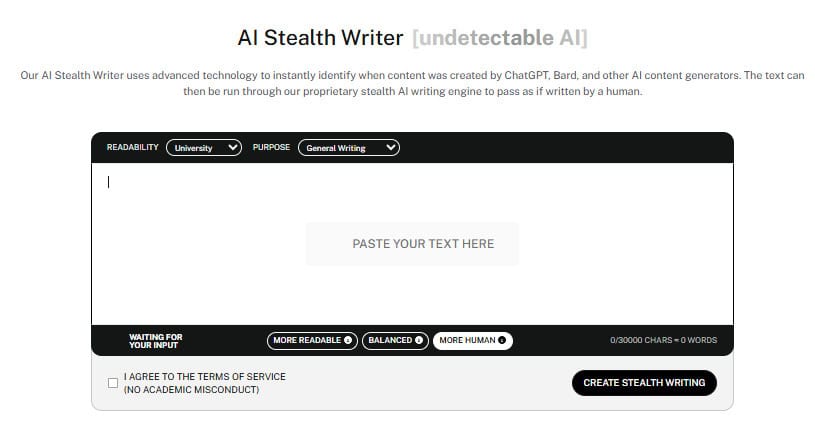
AI Paraphraser
Paraphrasing tool quickly rewords content while keeping the meaning intact, making it perfect for bypassing basic detectors. It:
- Quickly rephrases sentences with human variation.
- Helps beat basic AI detectors by shifting structure and language without losing meaning.
Best for: Quickly rewording content for SEO or avoiding duplication.
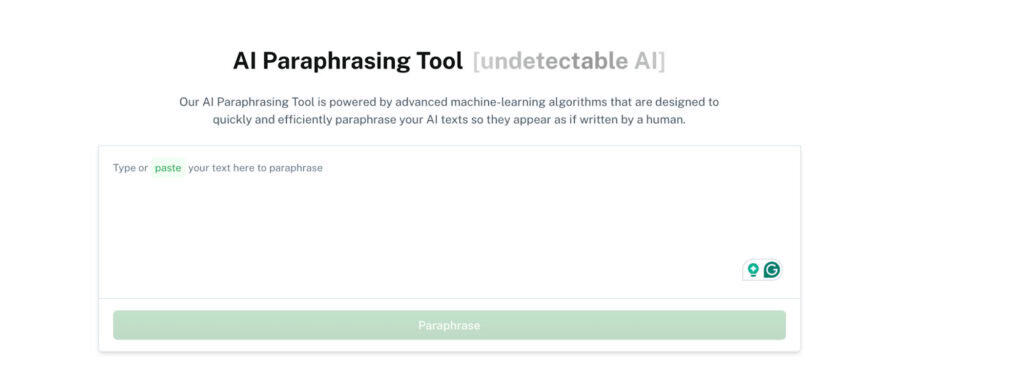
While you’re here, don’t forget to explore our AI Detector and Humanizer in the widget below!
What Are the Steps for Proofreading AI-Generated Content?
Proofreading AI-generated content is essential if you want it to sound polished, human, and trustworthy. Here’s a step-by-step process to make sure it’s ready for prime time:
- Read the Content Carefully From Beginning to End
Start by reading the content from start to finish, and check if everything flows logically. Identify if there are any awkward jumps in ideas or unclear transitions between paragraphs.
- Example: If one paragraph starts talking about “the future of technology” and then jumps straight to “how AI affects education” without a smooth transition, it can feel jarring.
- Check for Factual Accuracy
AI can sometimes make things up, or “hallucinate.” Double-check facts and data to avoid spreading misinformation.
- Example: If the content says, “The average person spends 5 hours on social media daily,” make sure this is backed up by current studies or reports.
- Check for Grammar, Spelling, and Punctuation Errors
Always do a manual check for grammar, spelling, and punctuation errors.
AI can miss small errors, and it doesn’t always catch the nuances of human language, such as tone or context.
- Check for Style and Readability
Check the content’s tone and ensure it fits your audience’s expectations.
Does it sound professional, casual, or friendly, depending on the context?
Adjust the flow to improve readability.
- Example: If the AI writes, “Moreover, this tool is highly beneficial,” but you want a more casual, conversational tone, you could rewrite it as, “Plus, this tool is super useful!”
Clue: Read the content out loud to see if it sounds natural. If you stumble or feel like something’s off, that’s a sign it needs to be adjusted.
- Check for Plagiarism
Even AI can occasionally lift text from other sources. Use tools like Copyscape or Originality.AI to ensure your content is original.
FAQs: Detecting AI Writing
Can AI detectors tell 100% if something is AI?
No. They use probability scores, not certainty. A 90% AI score means likely AI, not definite.
How accurate are free AI detectors?
Accuracy varies. Many flag human-written content as AI, especially if it’s formal or well-structured.
Can you detect ChatGPT writing specifically?
Only if the model is known. GPT-4 content is more natural and much harder to detect reliably.
Final Thoughts
There’s no finish line in the whole “detection vs. obfuscation” game. AI gets smarter, so do the detectors, and we all just try to keep up.
But maybe that’s the wrong way to look at it.
This isn’t just about dodging tools or rewriting AI-generated text until it “passes.”
It’s about authenticity. About doing the hard thing—thinking. Writing. Questioning. Letting AI writing tools support your ideas, not speak in your place.
Because at the end of the day, your name is on that byline. Not AI’s.
Use these tools. They’re powerful. But don’t skip the part where you sit with your words and ask: Does this sound like me? Would I say this out loud?
That’s the balance. That’s the work.
The future isn’t AI vs. humans. It’s AI with humans—only if we’re willing to show up and do the thinking.
